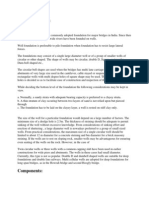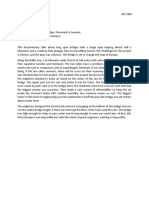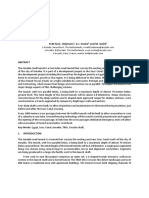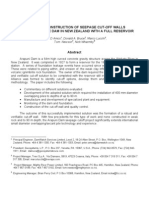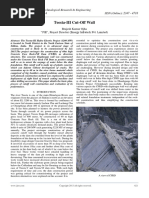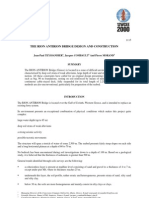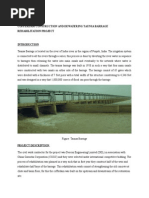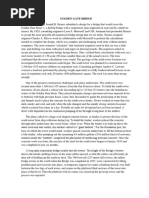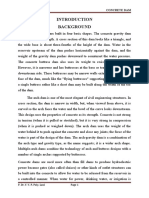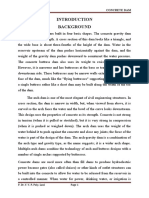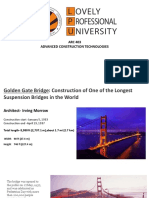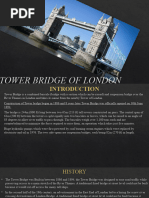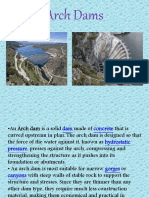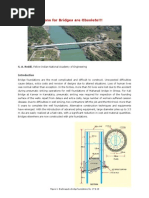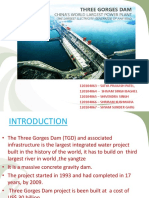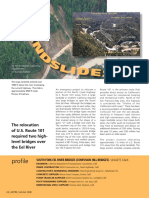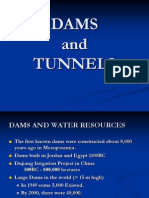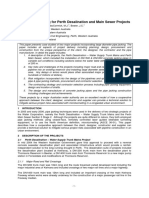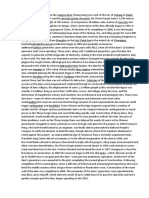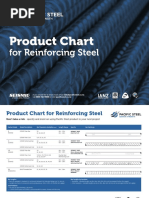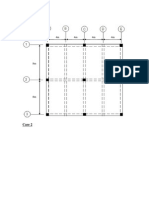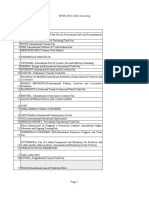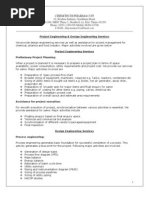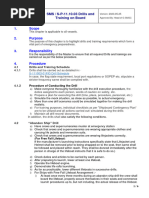Hoover Dam (USA) : Problem Technology/ Equipment
Hoover Dam (USA) : Problem Technology/ Equipment
Uploaded by
Edence PuahCopyright:
Available Formats
Hoover Dam (USA) : Problem Technology/ Equipment
Hoover Dam (USA) : Problem Technology/ Equipment
Uploaded by
Edence PuahOriginal Description:
Original Title
Copyright
Available Formats
Share this document
Did you find this document useful?
Is this content inappropriate?
Copyright:
Available Formats
Hoover Dam (USA) : Problem Technology/ Equipment
Hoover Dam (USA) : Problem Technology/ Equipment
Uploaded by
Edence PuahCopyright:
Available Formats
Hoover Dam (USA)
Hoover Dam is the highest and third largest concrete dam in the United
States. The dam is located in the Black Canyon of the Colorado River on the
Arizona-Nevada state line.
It is a concrete arch-gravity dam, standing 726.4 feet from foundation rock to
the roadway on the crest of the dam, weighing more than 6,600,000 tons. It can
support 45,000 pounds per square foot of maximum water pressure at its base.
Problem Technology/ Equipment
4 river diversion tunnels
(4000ft long, 56ft
diameter, lined with 3ft of
concrete) needed to be
built through the rock walls
of the canyon as soon as
possible, by the winter of
1932.
A drilling jumbo, 10-ton freight truck that was stripped
down to its chassis and welded on a semi-circular frame
that would support 4 platforms, and equipped with 2
levels of jackhammers was invented. The tunnels face
can be drilled by 30 jack-legs simultaneously.
To provide site access for
the workers and
equipment, connections to
aggregate quarries,
stockpiles and mixing
plant, and to haul out
tunnel muck during
excavation of diversion
tunnels.
Roads, rail spurs, suspension bridges, and electric
power transmission lines were established.
To prevent flooding of
water into the area of dam
sites construction.
Cofferdams were constructed upstream and
downstream of the dam site.
To make the canyon walls
surface smooth.
High scalers drill holes with air-powered jackhammers
for production blasting afterwards.
For the dam construction,
the great amount of
concrete blocks has to
cool rapidly and evenly to
prevent cracks.
A series of 1 inch pipes were embedded in concrete
blocks, through which ice water was circulated. The
worlds largest refrigerator capable of making 1000 tons
of ice a day was constructed at the site.
To alleviate problem of
internal heating of mass
concrete.
Low-heat cement was used, concrete was cast in blocks
small enough so that they would shrink as a monolithic
block and shrinkage cracks can be reduced.
The dam was built in
blocks or vertical columns.
Adjacent columns were locked together by a system of
vertical keys on the radial joints and horizontal keys on
the circumferential joints. Grout was injected into the
spaces between the blocks to turn the pieces into a
monolithic structure.
Panama Canal
The Panama Canal is 77km long and it facilitates shipping in region by
connecting the Pacific Ocean and Atlantic Ocean. This waterway has been a vital
route for trade in international maritime.
Problem Technology/ Equipment
Site access needed for workers and
transport of heavy machineries. An
efficient spoil disposal system has to be
established too.
- Panama Railroad was renovated with
heavier track and bridges upgraded to
accommodate more powerful engines.
- After renovation of Panama Railroad,
excavated earth can be dumped far away
from the dredging site to prevent slides
from refilling the exaction sites.
Panamanians topography required
machines that could function in a variety
of terrains and conditions.
Hydraulic cutter suction dredger with a
rotating cutter at the end of a suction line
was used. The edges of the rotating
blades can be changed, thus, allowing it
to adapt for cutting into various materials.
It could excavate 750cu.yd of material
per hour.
To prevent excavation sites from
drowning and machinery destroyed, at
the same time to reduce the amount of
excavation required.
- A temporary earthen dike across the
upstream section of the Chagres River
was built.
- Gatun Dam at the mouth of Chagres
river produced Gatun Lake, using this
impounded water, enormous locks lift
vessels up to the level of the lake.
Therere problem of landslide, an
example of major slide is the Cucuracha
slide. Approximately 382,000 cubic
metres of clay moved more than 4m in 24
hours.
- 100 Bucyrus steam were used to
excavate the slide. The largest shovels
were 95 tons with 5cu.yd dippers.
- Grading the slopes of the cut to a less
steep angle helps resolve problem of
landslides too.
When rocks are too large for the steam
shovels to handle or when rock-hard clay
were encountered during excavation.
Dynamite will be used to break the huge
rocks. Most of the dynamite was used at
the Culebra Cut. Holes were drilled and
filled with explosives.
Mass spoil needed to be removed
efficiently.
Wooden flatcars with a rated canal
capacity of 19cu.yd were used to haul
most of the spoil. They were built with
only one side with steel aprons bridging
the spaces between cars.
The tracks at the dumps needed constant
shifting to keep pace with the arriving
loads of spoil.
Track-shifter was invented. The huge
crane like machine would hoist a whole
section of track, swing it in either
direction to relocate it as much as 9ft.
The spoil left along the track by the spoil
unloader needed to be spread and
levelled.
Dirt- spreader was invented. It was a car
operated by compressed air, had steel
wings on each side that could be raised
and lowered.
Three Gorges Dam (China)
The Three Gorges Dam is the largest hydroelectric dam in the world. It is
located in the middle of the three gorges on the Yangtze River, the third longest in
the world, in the Hubei Province of China. The Three Gorges Dam has the purposes
of flood control, power generation, navigation, and tourism.
Problem Technology/ Equipment
During the river close off of the main
channel, it is crucial to prevent levee
breakdown during the bank-off advance.
- Water depth needed to be reduced. The
program of pre-levelling, upstream single
levee blocking, 2 directional bank-off
advance, and downstream follow-up
advance were adopted.
Approximately 2/3 of the cofferdam was
constructed underwater; geological
condition is complicated and not suitable
for building cut-off wall.
Advance equipment and new technology
such as high pressure screw shotcrete
was use.
During the river close-off on the diversion
channel, it is difficult to hold the fill
material on the slippery riverbed formed
with artificial concrete, with high inflow at
the same time.
The constructors applied steel-framed
rock cages and alloy steel nets to
roughen the bottom and to increase the
friction of the riverbed.
The mass quantity of concrete to be
placed; strict quality control, with
complicated structure and time constraint
are tough challenges.
- Hi-tower Flatliners are the main
equipment, gantry cranes, belt cranes,
and cable cranes as auxiliaries. Hi-tower
Flatliners is able to place concrete in
constraint areas of the dam.
- Continuous concrete production
technology was adopted.
- Computer simulation system for
concrete construction was developed.
Raw materials and gradation optimization
of concrete.
- High quality efficient water-reducing
agent was mixed with Grade I fly ash to
increase the durability of concrete.
- Mid-heat dam cement was used to
reduce contraction of concrete.
The temperature control and crack-
prevention of mass concrete is the key
and most difficult point for construction of
the dam.
Best raw materials were selected,
concrete mix ratio was optimized, two
times of pre-cooling aggregates was
used, concrete was mixed with cold
water and sliced ice, maintaining the
temperature of the exposed surface with
benzene board, etc.
Construction of high side slope of Three
Gorges Ship lock is very important.
Drainage from inside the ridge was
carried out, elimination of ground water,
installation of pre-stressed steel-cords,
and high-strength anchors, and support
with shotcreting.
Twin Towers (Malaysia)
Problem Technology/ Equipment
After borehole test being carried out, it
was discovered that the proposed site sat
effectively on the edge of a cliff. Half of
the site was decayed limestone and
another half was soft rock.
The entire site was moved 61m to allow
the building to sit entirely on the soft rock.
The choice between steel and concrete. Prohibitively high tariffs on imported steel
make concrete the construction material
of choice. Moreover, concrete structures
are stiffer and damp out vibration more
quicker.
The distance to bedrock varies
dramatically across each tower.
- Friction elements were used to
distribute load gradually in Kenny Hill.
- Concrete barrettes improved by skin
grouting were used.
- 13200 cubic meters of concrete in each
raft was cast in one continuous 50 hour
operation to avoid any construction joints.
- Chilled water was used and mat was
insulated for a month to minimize
differential temperatures.
To proposed a very strong foundation for
the superstructure.
13200 cubic meters of concrete in each
raft was cast in one continuous 50 hour
operation to avoid any construction joints.
The raft concrete contained 9% silica
fume to achieve the strength, workability
and cohesion.
Early into construction a batch of
concrete failed the strength test.
3 separate concrete plants being set up
on the site to ensure that if one produced
bad batch, the other 2 could continue to
supply concrete.
After some time of construction, Tower 1
was discovered to be leaning 25mm off
from vertical.
To correct the lean, the next 16 floors
were slanted back 20mm.
The two towers can sway in the wind
both in phase and out of phase, and twist
in independent directions, sky-bridge
could not be attached rigidly between the
vertical structures.
After being constructed on ground, the
sky-bridge was lifted into place on the
towers. The sky-bridge can slide in and
out of towers, this is to counterbalance
any effect from the wind. Tuned mas
dampers were installed to the slender
steel legs of the sky-bridge to prevent
excessive vibration of the bridge.
You might also like
- Well FoundationDocument56 pagesWell FoundationSriram Nandipati67% (3)
- Gaetos, Kristan Rae Y Bsce-V OJT-2336Document12 pagesGaetos, Kristan Rae Y Bsce-V OJT-2336Kristan Rae GaetosNo ratings yet
- Tunnel ConstructionDocument9 pagesTunnel ConstructionJayan VijayanNo ratings yet
- Bearing-Forces Calculations PDFDocument6 pagesBearing-Forces Calculations PDFAshish Premi100% (1)
- Multiple Fares Per Itinerary: Travel Agencies and Developer Administration Guide December 2016Document36 pagesMultiple Fares Per Itinerary: Travel Agencies and Developer Administration Guide December 2016单翀No ratings yet
- 1411306026400-Bit Bank - WorkshopDocument93 pages1411306026400-Bit Bank - WorkshopEr Rajesh BuraNo ratings yet
- Constructon A DamDocument14 pagesConstructon A DamjosephNo ratings yet
- Bridge Design ExampleDocument45 pagesBridge Design Examplechandra sekhar100% (3)
- Ismailia Road Tunnel Crossing The Suez Canal PDFDocument8 pagesIsmailia Road Tunnel Crossing The Suez Canal PDFRonald HeijmansNo ratings yet
- Deep Water FoundationDocument6 pagesDeep Water FoundationpushprajNo ratings yet
- Tunnels: BackgroundDocument6 pagesTunnels: BackgroundMarvin ZimmermanNo ratings yet
- 233 Design and Construction of Seepage Cut-Off WallsDocument17 pages233 Design and Construction of Seepage Cut-Off WallsNazakat HussainNo ratings yet
- Site Investigation Complete 2Document18 pagesSite Investigation Complete 2Dineesha ChiranNo ratings yet
- Teesta-III Cut-Off WallDocument7 pagesTeesta-III Cut-Off WallAnil KumarNo ratings yet
- K Ku Up Pa Arru Uk KR Riiv Ve Err S Su Ub BM Me Errssiib Blle Eb Brriid Dgge eDocument3 pagesK Ku Up Pa Arru Uk KR Riiv Ve Err S Su Ub BM Me Errssiib Blle Eb Brriid Dgge earslannderNo ratings yet
- Test Done in Akashi Kaikyo Bridge PDFDocument10 pagesTest Done in Akashi Kaikyo Bridge PDFCris BandaNo ratings yet
- Deep Shaft Design and ConstructionDocument14 pagesDeep Shaft Design and ConstructionFabio Nascimento100% (3)
- Golden Gate BridgeDocument19 pagesGolden Gate BridgeBhakti PatelNo ratings yet
- Rion Anti Rion BridgeDocument7 pagesRion Anti Rion BridgeNagar NitinNo ratings yet
- Golden Gate BridgeDocument49 pagesGolden Gate BridgeAbhishek Koul100% (1)
- Contents Page: Case Study: Three Gorges DamDocument10 pagesContents Page: Case Study: Three Gorges DamCara McAllorumNo ratings yet
- Civilnews 10Document8 pagesCivilnews 10adip1971890No ratings yet
- ch400 - Managing High Water InflowsDocument9 pagesch400 - Managing High Water InflowsJorge SalasNo ratings yet
- Case StudyDocument6 pagesCase Studyjaideep0% (1)
- solid 4 lab reportDocument10 pagessolid 4 lab reportAbel OmweriNo ratings yet
- Draft Golden GateDocument2 pagesDraft Golden GateDanang Adi KuncaraNo ratings yet
- Eg Unit 5Document20 pagesEg Unit 5Shifranth VarmaNo ratings yet
- Qingdao Gulf BridgeDocument3 pagesQingdao Gulf BridgeRafiath SiraNo ratings yet
- Curve Jacking - Paper Bangkok T-1ThorenDocument10 pagesCurve Jacking - Paper Bangkok T-1ThorenCheng KimHuaNo ratings yet
- Background: Concrete DamDocument15 pagesBackground: Concrete DamEr Dinesh TambeNo ratings yet
- Background: Concrete DamDocument15 pagesBackground: Concrete DamEr Dinesh TambeNo ratings yet
- Submitted To: Dr. Ali Shamim: Submitted By: Usman Naeem (11-CE-156)Document12 pagesSubmitted To: Dr. Ali Shamim: Submitted By: Usman Naeem (11-CE-156)KanjarvarNo ratings yet
- Golden Gate Bridge, 11811426 & 11815852Document17 pagesGolden Gate Bridge, 11811426 & 11815852Apoorva SinghNo ratings yet
- Tower Bridge of LondonDocument19 pagesTower Bridge of Londonsaurabh sahuNo ratings yet
- Document 1Document14 pagesDocument 1Mekete DessieNo ratings yet
- Three Gorges DamDocument5 pagesThree Gorges DamMark Dominic KipkorirNo ratings yet
- Well Foundations For Bridges Are ObsoleteDocument8 pagesWell Foundations For Bridges Are Obsoletesa_reddiNo ratings yet
- BehrensDocument9 pagesBehrensTony ChanNo ratings yet
- Civil Construction Project Development in The Himalayas Solving Geotechnical Challenges - HydroWorldDocument7 pagesCivil Construction Project Development in The Himalayas Solving Geotechnical Challenges - HydroWorldWkNo ratings yet
- Tunneling Problems For 1020 MW Tala Hydroelectric Project in Bhutan HimalayasDocument10 pagesTunneling Problems For 1020 MW Tala Hydroelectric Project in Bhutan HimalayasHarold TaylorNo ratings yet
- Tunneling - 14-10-2021Document41 pagesTunneling - 14-10-2021Usama UmarNo ratings yet
- High Head Small HydroDocument17 pagesHigh Head Small HydroCortney JohnsonNo ratings yet
- Three Gorges DamDocument26 pagesThree Gorges DamsatyaNo ratings yet
- TD PresentationDocument27 pagesTD PresentationMel FNo ratings yet
- Confusion Hill Sum08Document7 pagesConfusion Hill Sum08Nurali MamenNo ratings yet
- Pipeline Landfall - Cofferdam PDFDocument7 pagesPipeline Landfall - Cofferdam PDFdndudcNo ratings yet
- Design and Construction of Rion Antirion 'Charilaos TrikoupisDocument17 pagesDesign and Construction of Rion Antirion 'Charilaos TrikoupisApoorva SinghNo ratings yet
- Sloped Layers To Improve RCC Dam Construction - ForBESDocument5 pagesSloped Layers To Improve RCC Dam Construction - ForBESsharvan10No ratings yet
- Gravity Dam: DR SahooDocument26 pagesGravity Dam: DR SahooBibhuti Bhusan SahooNo ratings yet
- Tunnel and Shaft Construction For The Pingston Hydro ProjectDocument11 pagesTunnel and Shaft Construction For The Pingston Hydro ProjectZeynep Ahmet GülerNo ratings yet
- Dams and TunnelsDocument99 pagesDams and TunnelsVicente ScottNo ratings yet
- Extreme Excavation in Fault Zones and Squeezing Ground at The Kargi HEPP in TurkeyDocument11 pagesExtreme Excavation in Fault Zones and Squeezing Ground at The Kargi HEPP in TurkeynishantNo ratings yet
- A Report On Case Study of Three Gorges DamDocument12 pagesA Report On Case Study of Three Gorges DamRohan ShindeNo ratings yet
- Sutong Bridge FoundationsDocument16 pagesSutong Bridge FoundationsDimitris PantelakisNo ratings yet
- Pipa JackingDocument8 pagesPipa Jackingfikri ramadhanuNo ratings yet
- Kwan Golden GateDocument10 pagesKwan Golden GateLuis G WeigertNo ratings yet
- Introduction of dam engineeringDocument25 pagesIntroduction of dam engineeringSaiful HakimNo ratings yet
- Three Gorges Dam, Dam On The Yangtze River (Chang Jiang) Just West of The City of Yichang in HubeiDocument2 pagesThree Gorges Dam, Dam On The Yangtze River (Chang Jiang) Just West of The City of Yichang in HubeiДима ВасканNo ratings yet
- Building Landmarks - Bridges, Tunnels and Buildings - Architecture and Design | Children's Engineering BooksFrom EverandBuilding Landmarks - Bridges, Tunnels and Buildings - Architecture and Design | Children's Engineering BooksNo ratings yet
- Transactions of the American Society of Civil Engineers, vol. LXX, Dec. 1910 Reinforced Concrete Pier ConstructionFrom EverandTransactions of the American Society of Civil Engineers, vol. LXX, Dec. 1910 Reinforced Concrete Pier ConstructionNo ratings yet
- Transactions of the American Society of Civil Engineers, vol. LXVIII, Sept. 1910 The New York Tunnel Extension of the Pennsylvania Railroad. The East River Tunnels. Paper No. 1159From EverandTransactions of the American Society of Civil Engineers, vol. LXVIII, Sept. 1910 The New York Tunnel Extension of the Pennsylvania Railroad. The East River Tunnels. Paper No. 1159No ratings yet
- Transactions of the American Society of Civil Engineers, Vol. LXVIII, Sept. 1910 The New York Tunnel Extension of the Pennsylvania Railroad. The Cross-Town Tunnels. Paper No. 1158From EverandTransactions of the American Society of Civil Engineers, Vol. LXVIII, Sept. 1910 The New York Tunnel Extension of the Pennsylvania Railroad. The Cross-Town Tunnels. Paper No. 1158No ratings yet
- Bolt & Nut Range 2020 Web-2Document56 pagesBolt & Nut Range 2020 Web-2Edence PuahNo ratings yet
- Steelpipe Product Information Manual Sep 2019Document60 pagesSteelpipe Product Information Manual Sep 2019Edence PuahNo ratings yet
- PACST - Product Chart For Reinforcing Steel - 2017Document2 pagesPACST - Product Chart For Reinforcing Steel - 2017Edence PuahNo ratings yet
- AEFAC TN06 ConcreteDocument8 pagesAEFAC TN06 ConcreteEdence PuahNo ratings yet
- SESOC NZGS Piling Specification June Revision I FINAL 28 - 6Document66 pagesSESOC NZGS Piling Specification June Revision I FINAL 28 - 6Edence PuahNo ratings yet
- Module 6 Earthquake Resistant Retaining Wall Design Version 1Document80 pagesModule 6 Earthquake Resistant Retaining Wall Design Version 1Edence PuahNo ratings yet
- Inti Academic CalenderDocument1 pageInti Academic CalenderEdence PuahNo ratings yet
- Fyp Stage 2Document4 pagesFyp Stage 2Edence PuahNo ratings yet
- AIP SUP 06 2019 Mchauru AirportDocument6 pagesAIP SUP 06 2019 Mchauru AirportSHERIEFNo ratings yet
- TRADE FAIRS 13 08 2020 ChronologicalDocument25 pagesTRADE FAIRS 13 08 2020 ChronologicalJoyel DsouzaNo ratings yet
- Chemtech Pharmacon - Engineering ServicesDocument2 pagesChemtech Pharmacon - Engineering ServicesDilip KatekarNo ratings yet
- 5.3AUC 220511 1ssDocument3 pages5.3AUC 220511 1ssNor Azelin AzemanNo ratings yet
- 3 - Logistic Cost in Automotive IndustryDocument29 pages3 - Logistic Cost in Automotive IndustryDrPallati Sujendra100% (2)
- General - Aruba ArubaDocument4 pagesGeneral - Aruba ArubaВаня СемчёнокNo ratings yet
- Aircraft SizingDocument26 pagesAircraft SizingAgostino De GiuseppeNo ratings yet
- 148 Dec2013Document84 pages148 Dec2013Automan MagazineNo ratings yet
- Maritime Security Risks, Vulnerabilities and Cooperation Uncertainty in The Indian Ocean (PDFDrive)Document295 pagesMaritime Security Risks, Vulnerabilities and Cooperation Uncertainty in The Indian Ocean (PDFDrive)Kebede MichaelNo ratings yet
- Automotive Vehicles - Requirements of Footrests For Two-Wheeled Motor VehiclesDocument8 pagesAutomotive Vehicles - Requirements of Footrests For Two-Wheeled Motor VehiclesPraveen KumarNo ratings yet
- Railway Labor Executives' Association v. Pittsburgh & Lake Erie Railroad Company, 884 F.2d 744, 3rd Cir. (1989)Document3 pagesRailway Labor Executives' Association v. Pittsburgh & Lake Erie Railroad Company, 884 F.2d 744, 3rd Cir. (1989)Scribd Government DocsNo ratings yet
- Topic Form - FootbridgeDocument1 pageTopic Form - FootbridgeMark Alfred LanuzaNo ratings yet
- Essay On Travelling 2Document1 pageEssay On Travelling 2Lilia SomerNo ratings yet
- HSE Risk Register and Risk AssesmentDocument29 pagesHSE Risk Register and Risk AssesmentAllen ArockiarajNo ratings yet
- Turbine1 FinalDocument7 pagesTurbine1 Finalmohd shahir100% (2)
- Based On The Examination, Each Bridge Is Outlined in Table 2-8 and 2-9Document30 pagesBased On The Examination, Each Bridge Is Outlined in Table 2-8 and 2-9ShaileshRastogiNo ratings yet
- d6Rc1 Press ChartDocument3 pagesd6Rc1 Press ChartTóth KrisztiánNo ratings yet
- S-P-11.10.03 Drills and Training On BoardDocument6 pagesS-P-11.10.03 Drills and Training On Boardyo binNo ratings yet
- Fire-Fighting Systems For On-Deck Cargo Areas of Container CarriersDocument12 pagesFire-Fighting Systems For On-Deck Cargo Areas of Container CarriersSeong Ju KangNo ratings yet
- Yamaha Malta ManualDocument57 pagesYamaha Malta ManualDNJacksonNo ratings yet
- Berkshire Locomotive - WikipediaDocument1 pageBerkshire Locomotive - WikipediaJoseph CelayaNo ratings yet
- Practical Research Group 5Document34 pagesPractical Research Group 5mrjamesliboonNo ratings yet
- Citadel Lines, Inc. vs. Court of Appeals, 184 SCRA 544, G.R. No. 88092 April 25, 1990Document8 pagesCitadel Lines, Inc. vs. Court of Appeals, 184 SCRA 544, G.R. No. 88092 April 25, 1990Sam WelbyNo ratings yet
- Saudi Electricity Company: RevisionsDocument9 pagesSaudi Electricity Company: RevisionsPrabhakar SvNo ratings yet
- Ehamvidp PDF 1693135808Document111 pagesEhamvidp PDF 1693135808Maurits VeenNo ratings yet
- MS 02 Asphalt Mix Design, 7th Edition, 2014Document2 pagesMS 02 Asphalt Mix Design, 7th Edition, 2014Shafiqullah GowharyNo ratings yet
- The Dry Port Concept - Theory and PracticeDocument13 pagesThe Dry Port Concept - Theory and PracticeWegit TriantoroNo ratings yet
